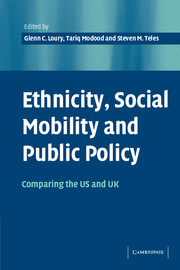Book contents
- Frontmatter
- Contents
- List of figures
- List of tables
- List of contributors
- Acknowledgements
- Introduction
- Part I Historical overviews
- Part II Informal social networks
- Part III Formal structures
- Part IV Political institutions and processes
- 16 Ethnicity and political mobilization in Britain
- 17 Political institutions and minority mobility in the USA
- 18 Race, state, and policy: the development of employment discrimination policy in the USA and Britain
- 19 Regime effects: ethnicity, social mobility, and public policy in the USA and Britain
- Part V Normative analysis
- Author index
- Subject index
- References
19 - Regime effects: ethnicity, social mobility, and public policy in the USA and Britain
Published online by Cambridge University Press: 22 September 2009
- Frontmatter
- Contents
- List of figures
- List of tables
- List of contributors
- Acknowledgements
- Introduction
- Part I Historical overviews
- Part II Informal social networks
- Part III Formal structures
- Part IV Political institutions and processes
- 16 Ethnicity and political mobilization in Britain
- 17 Political institutions and minority mobility in the USA
- 18 Race, state, and policy: the development of employment discrimination policy in the USA and Britain
- 19 Regime effects: ethnicity, social mobility, and public policy in the USA and Britain
- Part V Normative analysis
- Author index
- Subject index
- References
Summary
Introduction
What accounts for the social mobility of racial and ethnic groups in liberal capitalist democracies? How do polities, consciously or not, accelerate or retard these groups' advancement? And how might these polities differentially affect the opportunities of various groups to “get ahead”? Drawing on a broader understanding of social mobility than is traditionally employed, this paper compares contemporary racial and ethnic groups in the USA and Great Britain on three crucial aspects of social mobility. In doing so, we emphasize what might be called the regime effect: the consequences for different ethnic groups inhabiting polities that differ in their mix of political institutions and policy instruments. After outlining below our understanding of social mobility, we proceed by tackling in turn three essential, if underappreciated, aspects of social mobility: wealth accumulation; crime; and health.
Scholars have traditionally conceived of social mobility in terms of an individual's position in the labor market, whether measured by occupational strata or income level (Blau and Duncan 1978, Duncan 1984, Erikson and Goldthorpe 1992). “Mobility” refers either to individuals over the course of their life cycle, or across generations. By generating income and by securing status benefits that accompany various employment categories, individuals are conceived of as climbing up, slipping down, or remaining on the same rung of a social ladder common to all in the polity.
- Type
- Chapter
- Information
- Ethnicity, Social Mobility, and Public PolicyComparing the USA and UK, pp. 522 - 570Publisher: Cambridge University PressPrint publication year: 2005
References
- 2
- Cited by



